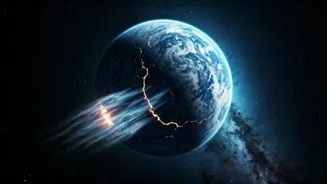The Runaway Discovery
Scientists have stumbled upon a rogue planet demonstrating an extraordinary growth spurt. This planet, unattached to any star, is consuming material at an unparalleled
rate, setting it apart from other known celestial objects. Located within the Chamaeleon constellation, this giant planet's behavior challenges existing models of planetary formation and evolution. Its existence pushes the boundaries of what we understand about how planets can form and grow, even without the gravitational pull of a star. This fascinating find has generated excitement among researchers, urging them to delve deeper into the mysteries of this unusual celestial wanderer.
Blurring Planet-Star Lines
The discovery of a rogue planet with such an aggressive appetite blurs the conventional boundaries that typically distinguish stars and planets. Traditionally, planets are thought to form within the discs of gas and dust that circle young stars, accreting material over millions of years. This new find suggests that a planet can develop and undergo intense growth without the direct influence of a star. Its rapid consumption of matter suggests the possibility of unique formation processes, potentially involving interactions with interstellar material or remnants of planetary formation that are very different from what we previously conceived. The implications of this discovery have prompted scientists to reconsider planetary formation theories and the role of interstellar space in shaping celestial bodies.
Secrets of Future Telescopes
To fully understand the characteristics of this rogue planet, scientists are looking forward to harnessing the power of advanced telescopes that are currently under development. Instruments such as the next-generation space telescopes will offer improved capabilities for detailed observation. These sophisticated tools will offer unprecedented insights into the planet's atmosphere, composition, and the mechanisms behind its accelerated growth. By analyzing the light emitted and reflected by the planet, researchers hope to uncover valuable clues about its formation history and the materials it is consuming. The anticipation is high as these telescopes will open a new era of exploration in understanding the behavior of these celestial wanderers and their place in the cosmos.
A Giant in Chamaeleon
The rogue planet resides in the Chamaeleon constellation, a region known for its stellar nurseries and young star systems. This planetary giant's location provides context for its unique behavior. This is a region rich in interstellar gas and dust, where rogue planets can freely interact with the raw materials of the universe. The surrounding environment may be playing a key role in driving the planet's remarkable growth rate. By studying this environment and how it affects the rogue planet, scientists can gain a better comprehension of planetary formation processes, offering a fascinating glimpse into the dynamic evolution of celestial objects. This discovery provides valuable new insights to further study the planets in that area.

